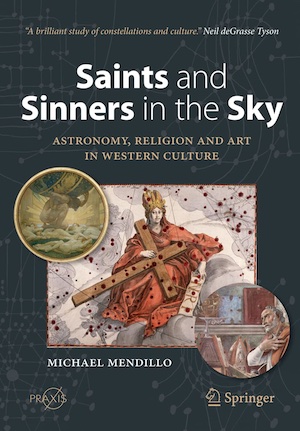By Jay M. Pasachoff
There is a main line of star maps with the constellations we all know (88 officially from the International Astronomical Union in the 1920s), mostly descending from Alessandro Piccolomini (1543) and the much finer Johan Bayer’s 1603 Uranographia with its 52 plates on which he assigned the Greek letters we still use for the brightest stars. Later sets of charts by English Astronomer Royal John Flamsteed (with French translations from the English in 1776 and 1796 published in a smaller format) and a huge book by Johann Bode (1804) followed Bayer’s choices, with an elaborately printed more-general book by Andreas Cellarius (1660). Also beautifully engraved and printed were atlases by John Bevis (with its plates printed in 1748 but not bound and published until 1786) and Elijah Burritt (1835). Among the numerous illustrations Michael Mendillo publishes are hemispheric comparisons of Julius Schiller and Andreas Cellarius. He doesn’t include the most recent sky charts by celestial cartographer Wil Tirion, such as those in my own Peterson Field Guide to the Stars and Planets or the dozen zodiacal drawings done for me by Robin Brickman for my Peterson First Guide to Astronomy.
But in Saints and Sinners in the Sky: Astronomy, Religion and Art in Western Culture, Mendillo, a professor at Boston University, not only interestingly reviews the standard atlases but also singles out a Christian version by Schiller in 1627. I wish readers of this review could join my students and me this fall as we (a new set of students, of course) again hear Mendillo lecture about his collection of atlas charts, mostly unbound, to my Great Astronomers and their Original Publications rare-book course at Williams College. Anyway, Mendillo points out that the general agreement centuries ago that 12 is a significant number led to the dozen zodiacal constellations. So it was natural for Schiller to substitute a dozen biblical figures.
For example, in his 1627 Coelum Stellatum Christianum, Schiller substituted Saints for Alessandro Piccolomini’s and Johann Bayer’s constellations based on Greek myths. His Christianized substitutions in the northern hemisphere (chapter four) replaced Aries with St. Peter, St. Andrew for Taurus, St. James for Gemini, St. John for Cancer, St. Thomas for Leo, and St. James (the Lesser) replacing Virgo. Outside of the zodiac, Cygnus replaced by St. Helen seems to be the only female Saint pictured by Schiller. In chapters four and five, Mendillo describes who all these personages were, and provides Piccolomini, Bayer, and Schiller plates from his collection for comparison. In the southern sky, he put St. Phillip for Libra; St. Bartholomew replaced Scorpius; St. Matthew replaced Sagittarius; St. Simon replaced Capricornus; St. Jude Thaddeus replaced Aquarius; and St. Matthias replaced Pisces.
The rest of the book includes numerous color renditions of other astronomical imagery, including Giotto di Bondone’s Star of Bethlehem from Padua that had been pointed out by Roberta J.M. Olson as Halley’s Comet’s passage of 1301 [which led me to arrange for asteroid (471301) Robertajmolson to be named for her in the asteroid belt along with my own (5100) Pasachoff]. It includes color imagery over centuries, as far back as the A.D. second-century Farnese celestial globe now displayed in Naples, and even samples of Joan Miró’s and Pablo Picasso’s paintings. Modern works by Joseph Cornell, Georgia O’Keefe, and Jasper Johns are also included.
Mendillo’s book is a fascinating, well-illustrated, and nicely produced book (though hardbound in a larger format would have been even better). I recommend Saints and Sinners in the Sky highly to all interested in beautiful illustrations relevant to astronomy and to everyone—for who isn’t glad to learn more about the constellations.
Astronomer and author Jay M. Pasachoff (ΦBK, Williams College) is the director of the Hopkins Observatory and Field Memorial Professor of Astronomy at Williams College. He is a visitor in the Carnegie Observatories. Williams College is home to the Gamma of Massachusetts chapter of Phi Beta Kappa.




